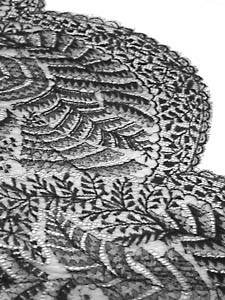![[Metroactive Features]](http://metroactive.com/features/gifs/feat468.gif)
[ Features Index | Silicon Valley | Metroactive Home | Archives ]
Lace Museum
By Sarah Quelland
THERE'S MORE to lace than doilies and antimacassars. Bug lace decorated with the hard iridescent shells of scarab beetles; human-hair flower sculptures and wreaths; a vest made from human hair and gold-wrapped thread--these are just a small sample of the surprises displayed at the Lace Museum in Sunnyvale.
Housed at the end of a shabby little strip mall, the Lace Museum calls itself the only one of its kind in America. Lace makers, historians and enthusiasts come from all over the world to visit. At first sight, the museum doesn't appear all that impressive. But a guided tour with a delightful volunteer docent named Ruth--who, as befits her position, wears an unusual pendant made from recycled Chantilly lace--proves otherwise. This small space holds hundreds of unexpected little treasures.
My impromptu tour starts with a crash course in the history of lace. Ruth explains that the spider is considered the first lace maker. She then shows me other examples of "nature's lace." Among them: stones like lace agate and, even better, crazy lace agate from Mexico; lacewing insects; lace wood; lace bark; and Queen Anne's lace.
The museum includes numerous displays explaining the seven techniques of lace making: tatting, tape, crocheting, bobbin, netted, fillet and needlepoint. Look also for a display of the various fibers used to make lace: silk, cotton, wool and flax (linen). Showing me an example of fine flax lace, Ruth tells me it would take 30 hours just to produce one square inch--except that, because of the way flax is grown today, lace that fine can't even be produced anymore.
Ruth unrolls several quilts made from beautiful lace, some embroidery samples and a few pedipoint handkerchiefs, some of which date back to the 1920s. She explains that oftentimes people must use magnifying glasses when doing such extremely fine and detailed work.
Established in 1976 and at its present location since 1994, the Lace Museum is a nonprofit organization that was founded to preserve old lace and to teach the art of lace making. Supported by the Lace Museum Guild, volunteers run the show. Everything in the collection is donated. According to Ruth, the museum owns so many lace and lace-related artifacts, it could go 10 years without exhibiting the same items twice. The Lace Museum hosts classes taught by volunteers and brings in guest teachers to talk about various lace-making techniques. The museum sells lace-making supplies (including threads, bobbins, beads and buttons) and reference materials in its small gift shop.
One of the museum's prize pieces is a lace tablecloth from World War I. Back then, kings and presidents would present each other with ceremonial pieces decorated with national symbols as a tribute to the alliances they'd made. In this case, the United States, France, Great Britain, Japan, Portugal, Rumania, Italy, Serbia, Montenegro and China are represented. At nearby Stanford University, war lace given to Herbert Hoover and his wife is on display in the Hoover Tower. These wonderful little scraps of history are out there if we just look.
Lace is a versatile thing that shares our lives, be it decorating the curtains and bedspreads in our homes or trimming the clothes that we wear. It can be frilly and old-fashioned, sweet and girlish, or feminine and sexy. But what's particularly fascinating about lace is its place in history and the unique histories behind each piece. That bug lace dates back to 1880. The human-hair vest was made in 1865. And those human-hair flower sculptures and wreaths are somebody's long-lost family heirlooms from the Civil War era.
Carefully handling one of the aging, brown hair sculptures, Ruth tells me, "Some people think it's eerie." She seems pleased, though, that I don't. As she places it back in its temporary storage box, I can't help wondering what lineage a DNA test might turn up.
Favorite Local Collections
Rite of Pez-age: The Museum of Pez Memorabilia in Burlingame.
The Hole Truth: Lou's Living Donut Museum in San Jose.
Composing a Life: The Ira F. Brilliant Center for Beethoven Studies at San Jose State University.
Waste Not: The Garbage Museum in Milpitas.
Lofty Ambitions: The Wings of History Museum in San Martin.
High-Tech Hit Parade: The Intel Museum in Santa Clara.
History Lesson: The Japanese-American Museum of San Jose.
Beyond the Doily: The Lace Museum in Sunnyvale.
Museums: A complete guide to local museums.
[ Silicon Valley | Metroactive Home | Archives ]
Copyright © Metro Publishing Inc. Metroactive is affiliated with the Boulevards Network.
For more information about the San Jose/Silicon Valley area, visit sanjose.com.
![]()

Beyond the Doily
Lace Museum Hours: Tue-Sat, 11am-4pm, and by appointment. Admission: Free, donation requested; group tours $50. Current Exhibit: 'The Roaring '20s: Dresses and Accessories From the '20s Into the '30s.' 552 S. Murphy Ave., Sunnyvale; 408.730.4695. www.thelacemuseum.org
Send a letter to the editor about this story to letters@metronews.com.
From the March 13-19, 2003 issue of Metro, Silicon Valley's Weekly Newspaper.